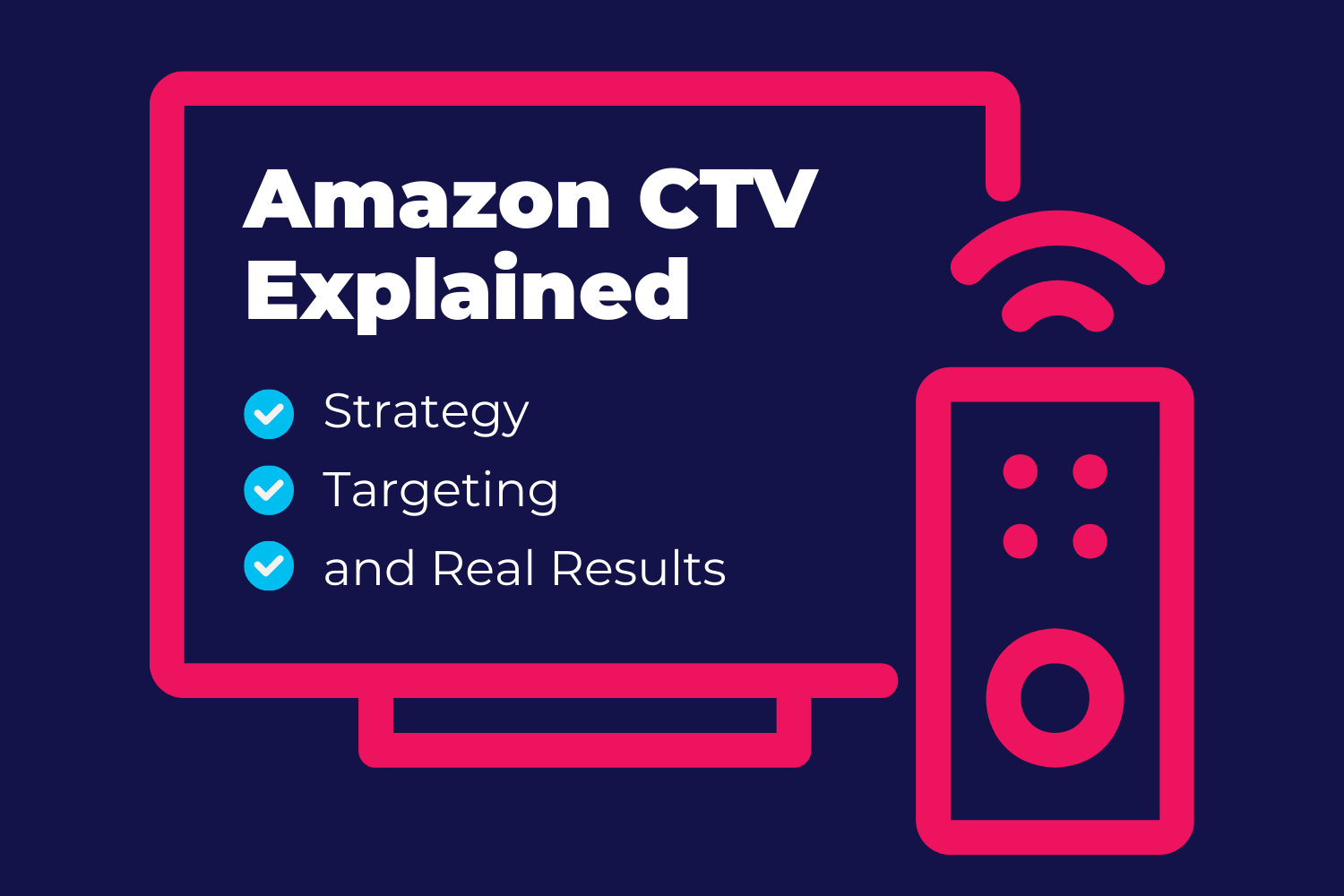CTV Advertising Strategy: A Complete Guide for Agencies
| Pathlabs Marketing |
| July 9, 2025 |
CTV advertising enables marketing agencies to deliver targeted video ads across various streaming platforms, providing a powerful alternative to traditional TV advertising. 70% of people report watching CTV video content as part of their TV viewing behavior, with the average daily CTV watch time in the US being nearly 2 hours and 15 minutes. As agencies integrate CTV into their broader media strategy, they face challenges such as precise audience targeting, accurate measurement, and seamless cross-channel integration.
This guide explores best practices for CTV success, including audience segmentation, campaign optimization, and innovative approaches like Pathlab’s data-driven execution.
Building A Winning CTV Advertising Strategy
A strong CTV advertising strategy combines data-driven insights, precise audience targeting, and seamless cross-platform execution. Agencies must navigate a fragmented landscape, balancing reach and relevance while optimizing campaigns for performance. Success hinges on leveraging programmatic technology, real-time analytics, and a deep understanding of viewer behavior.
Using First-Party Data, Cross-Channel Insights, and Programmatic Targeting
Effective CTV advertising relies on quality inventory management that enables marketing agencies to create highly relevant and personalized campaigns. When combined with cross-channel insights, it provides a deeper understanding of audience behavior across platforms, enabling smarter media buying decisions.
Programmatic targeting further enhances efficiency, ensuring ads reach the right viewers at the right time. For example, agencies can utilize first-party data to retarget engaged audiences across CTV, mobile, and desktop devices, thereby maximizing campaign impact. A Media Execution Partner (MEP) that specializes in leveraging data-driven strategies, such as Pathalabs, is exceptionally well-equipped to execute precise and scalable CTV campaigns, delivering stronger, measurable results.
Choosing the Right CTV Platforms
With the increasing number of CTV platforms available, agencies must carefully select those that align with their audience demographics and campaign objectives. Some CTV inventory packages offer broad reach through popular streaming platforms, making them ideal for campaigns with large budgets. Others provide cost-efficient and flexible targeting opportunities through free ad-supported television (FAST) channels and advertising-based video on demand (AVOD) platforms. Understanding factors like ad formats, inventory availability, and measurement capabilities is crucial for optimizing performance.
For instance, platforms like Hulu and Roku cater to premium audiences, while YouTube and Pluto TV offer more diverse viewership. Pathlabs helps agencies navigate this complexity, ensuring their media investment is optimized across the best CTV video channels for maximum engagement and efficiency.
Selecting the Best CTV Ad Formats
CTV advertising offers various ad formats, each serving different campaign objectives. Agencies must balance performance goals with user experience for maximum impact.
For example, a brand seeking to boost conversions may benefit from clickable CTV ads that direct viewers to a dedicated landing page. Pathlabs helps agencies evaluate the best ad formats for their audience, ensuring seamless execution and measurable success across multiple CTV platforms.
Strategies for Cross-Channel Success
An effective cross-channel strategy ensures that CTV campaigns work in tandem with other digital advertising efforts, including social media, display, and search. An agency has to unify messaging, leverage data insights, and optimize creative assets across platforms to enhance brand consistency. For instance, syncing CTV campaigns with social retargeting can reinforce messaging and drive higher engagement.
The Biggest CTV Advertising Challenges Agencies Face
Agencies navigating the CTV landscape face several challenges, including fragmented platforms and measurement difficulties. One of the biggest hurdles is placing an ad strategically to reach the right audience while avoiding ad fatigue. Without precise targeting, ads may fail to resonate, leading to wasted spend.
Additionally, cross-channel integration remains complicated, making it challenging to create a seamless brand experience across CTV, social media, and display ads. As agencies refine their CTV strategies, staying ahead of evolving viewer behaviors and platform capabilities is crucial for maximizing campaign effectiveness and return on investment.
Ad Waste and Inefficient Targeting
Ad waste remains a challenge in CTV advertising, often stemming from inefficient delivery and poor audience segmentation. Without precise targeting, agencies risk serving ads to viewers who are unlikely to engage, leading to inflated costs and minimal returns. Native video ads can help combat this challenge by blending seamlessly with content, creating a more engaging and less intrusive ad experience.
However, ensuring these ads reach the right audience at the right time requires data-driven strategies and robust measurement tools. Agencies must refine their targeting approaches to reduce waste and maximize the impact of every ad dollar spent.
Neglecting Cross-Platform Optimization
CTV campaigns don’t exist in isolation. Without a cohesive strategy across multiple channels, agencies risk missing valuable opportunities to engage with their audience. A key challenge is ensuring connected TV ads align with other digital efforts, such as mobile and social campaigns, to create a seamless brand experience.
Many agencies struggle with fragmented data, leading to inconsistent messaging and ineffective retargeting. Cross-platform optimization is crucial for enhancing brand awareness and increasing engagement. By integrating insights from various channels, agencies can refine their targeting and deliver more impactful campaigns that drive conversions and long-term customer relationships.
Poor Measurement Framework and Attribution Gaps
One of the biggest frustrations for agencies in CTV advertising is the lack of standardized measurement and attribution models. Without clear metrics, proving campaign effectiveness becomes challenging, making it difficult to optimize future ad spend. Traditional TV metrics don’t translate well to streaming, and different CTV platforms offer varying levels of data transparency.
Agencies need robust attribution frameworks to track engagement, viewership, and conversions accurately. Addressing these gaps requires leveraging advanced analytics, cross-channel insights, and third-party verification tools to ensure that CTV campaigns deliver measurable impact and drive business growth.
Measuring CTV Advertising Strategy Success
Understanding whether a CTV advertising strategy is truly effective requires a multi-faceted approach to measurement. Metrics such as engagement rates, conversion tracking, and audience retention provide valuable insights into campaign performance. However, aligning CTV efforts with broader retail media advertising strategies can enhance attribution and optimize budget allocation.
Agencies must leverage advanced analytics to connect ad impressions with consumer actions, ensuring that every dollar spent contributes to business goals. By continuously refining measurement frameworks, advertising professionals can adapt to evolving viewer behaviors and maximize the impact of their CTV campaigns.
Key Performance Indicators
When evaluating CTV ad success, agencies must track the right Key Performance Indicators (KPIs) to gain actionable insights. Metrics such as cost per acquisition, completion rates, and return on ad spend help determine the effectiveness of a campaign. However, measuring beyond traditional TV metrics is vital, as engagement time, viewability, and post-view conversions provide deeper audience insights.
Inventory quality also affects KPIs. Inventory quality, or the trustworthiness, relevance, and effectiveness of the ad placements available on connected TV platforms, directly impacts core CTV KPIs, such as completion rate, viewability, and invalid traffic. High-quality inventory ensures that real viewers see ads in brand-safe environments. Without transparency and fraud protection, even strong targeting can fail to deliver meaningful outcomes or return on ad spend.
A data-driven approach ensures that CTV campaigns align with broader business objectives, enabling agencies to refine their strategies and create growth. By continuously monitoring KPIs, advertisers can optimize their campaigns, ensuring maximum reach, relevance, and return on investment.
Real-Time Audience Reporting and Advanced Data Analytics
The ability to track and analyze campaign performance in real-time is a game-changer for CTV advertising. Real-time audience reporting allows agencies to see how viewers engage with content, adjust placements, and boost targeting accurately.
Advanced data analytics offer deeper insights into audience preferences, viewing habits, and cross-device behavior, enabling advertisers to refine their messaging. By leveraging real-time data, agencies can optimize campaigns mid-flight, ensuring that ads reach the right audience at the right moment. This level of agility and precision is key to maximizing ROI and staying ahead.
Audience Segmentation and Dynamic Campaign Adjustments
CTV advertising success hinges on precise audience segmentation and the ability to dynamically adjust campaigns. Instead of a one-size-fits-all approach, agencies must leverage data-driven segmentation to deliver personalized experiences. By analyzing factors such as demographics, viewing behavior, and engagement patterns, advertisers can tailor their messaging to different audience segments.
Dynamic campaign adjustments, such as shifting budgets to high-performing platforms or modifying creatives based on real-time insights, also help improve overall efficiency. This level of adaptability ensures that CTV campaigns remain relevant, engaging, and impactful, ultimately driving better results and higher audience retention.
Future Trends In CTV Advertising That Agencies Should Watch
As streaming continues to dominate, agencies must stay ahead of emerging trends in CTV advertising to remain competitive. Expect greater integration of AI-powered ad targeting, enabling brands to serve highly relevant ads in real-time. Cross-platform measurement advancements will enhance attribution, bridging the gap between streaming and traditional media.
The rise of interactive and shoppable ads will redefine audience engagement. Agencies that embrace these innovations will deliver more impactful campaigns, ensuring they meet evolving viewer expectations while optimizing ad spend. Staying informed on these trends is crucial for long-term success in the CTV space.
AI-Driven Ad Personalization
AI-driven ad personalization is transforming CTV advertising by enabling agencies to serve highly relevant content to viewers based on behavioral insights. Machine learning (ML) algorithms analyze real-time data to predict audience preferences and optimize ad placements for maximum engagement. This approach goes beyond basic demographic targeting, allowing brands to personalize messages dynamically.
AI can adjust ad creatives based on time of day, previous interactions, or even mood indicators. By leveraging AI, advertisers can enhance user experiences, boost conversion rates, and reduce ad fatigue. The result? Smarter, more efficient campaigns that deliver value to brands and audiences.
Advanced Audience Segmentation with Predictive Analytics
Effective audience segmentation is no longer just about demographics; it’s about leveraging predictive analytics to anticipate viewer behavior. By analyzing viewing habits, past interactions, and engagement patterns, agencies can create highly refined audience segments that drive better ad performance. Predictive analytics allows advertisers to serve content tailored to individual preferences, ensuring higher relevance and reduced ad waste.
For example, a sportswear brand can target fitness enthusiasts based on their streaming choices and online activity. This level of precision enhances engagement and maximizes ROI, making CTV advertising a more strategic and results-driven investment for brands.
Shoppable CTV Ads and Interactive Video Formats
Shoppable CTV ads and interactive video formats are transforming the way brands engage with their audiences. These formats enable seamless, in-content purchasing experiences, allowing viewers to engage with products directly from their screens.
Imagine watching a cooking show and instantly purchasing the featured ingredients with a click. Interactive ads also drive engagement through polls, quizzes, and personalized recommendations, making the ad experience more immersive.
For agencies, this means a shift toward storytelling-driven commerce, where ads are not just viewed but actively engaged with. The future of CTV advertising lies in engagement, interactivity, and direct consumer action.
How Agencies Can Optimize Their CTV Advertising Strategy
Optimizing your CTV advertising strategy requires a data-driven approach, precise audience targeting, and seamless cross-platform execution. As streaming consumption continues to rise, agencies must stay ahead by leveraging advanced analytics, AI-driven personalization, and real-time performance tracking.
At Pathlabs, we understand that successful CTV advertising requires a blend of data-driven insights, creative excellence, and cutting-edge technology. Our approach focuses on precision targeting, real-time optimization, and seamless cross-platform execution to ensure maximum impact.
We leverage AI-powered analytics, predictive audience segmentation, and interactive ad formats to deliver high-performance campaigns, whether the goal is enhancing CTV and OTT advertising strategies or integrating shoppable ad experiences.









